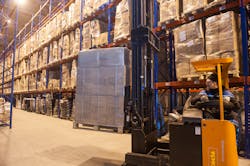eCommerce Increase Will Lead to Warehousing Issues in 2022
Not surprisingly, CBRE is predicting that real estate will stay hot in 2022. In its report, U.S. Real Estate Market Outlook for 2022, the group cites record demand, rent growth and investment activity, as the underlying reasons for the growth.
Other trends include eCommerce expansion that will fuel the need for more warehouse space, along with the “growing economy, population migration and the desire for ‘safety stock’ onshore.” E-commerce sales grew 21.6% to total retail sales for Q2 2020, which was up from 16.2% the previous quarter, as the result of the pandemic. And for Q3 2021, sales are still above pre-pandemic levels at 20%. This trend will continue in 2022.
As the eCommerce sales continue, so too does the need for more warehouses. InQ3 of 2021, 448.9 million sq. ft. of space was under construction, which sets a record. This number does reflect projects that were not completed due to the pandemic. And this demand will continue, the report notes. “In 2022, availability will remain tight, particularly for Class A space, leading to a higher number of lease renewals. While this will support high rents, it may slow the pace of new leasing activity in 2022.”
For these reasons and others, such as a lack of available space in highly populated areas and challenges with finding enough workers to operate facilities, retailers and wholesalers will look to outsource functions to third-party logistics companies (3PLs).
High Shipping Costs
The extremely high shipping costs in 2021, should ease in 2022. The cost to ship goods via ocean freight increased more than 200% in 2021 and the cost for domestic freight increased over 40%, according to Drewry Supply Chain Advisors and the Cass Freight Index. The report sees this level tapering off, but costs will remain elevated for the foreseeable future. While manufacturers continue to ramp up, it will take them until 2023 to fully recover says CBRE, keeping transportation costs high.
In addition to catching up, demand will continue to rise resulting in more competition for transportation. Transportation costs make up 40%-70% of a company’s total logistics spend, according to CBRE’s Supply Chain Advisory.
Emerging Logistics Markets
The report predicts that markets like Nashville, Las Vegas, Reno, Central Valley California, Salt Lake City, Central Florida, San Antonio and Austin should see significantly more activity in 2022. Inland port markets with both air and rail capability will also see increases in 2022. Those ports would include, Louisville, Memphis, El Paso, Columbus, Indianapolis, Kansas City, St. Louis and Greenville.
